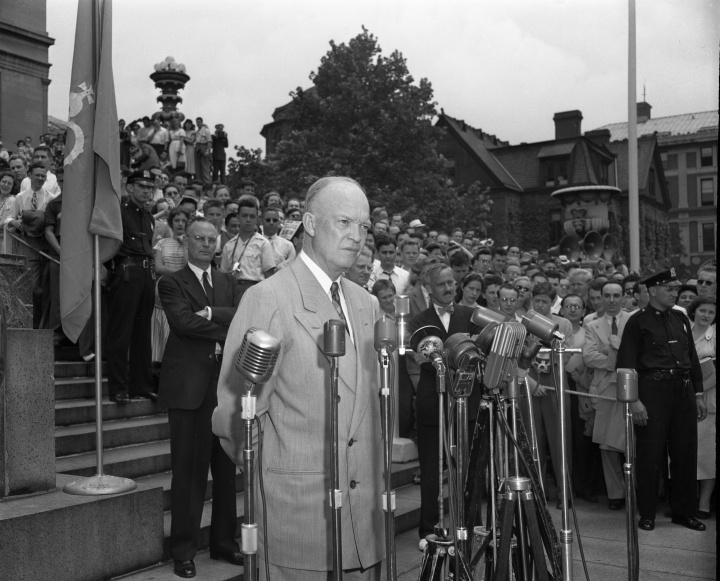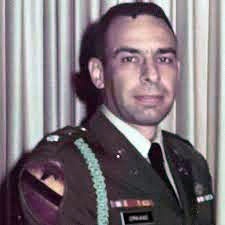Columbia College | Columbia University in the City of New York
Ike and the Class of Destiny

University President Dwight D. Eisenhower addresses a crowd of summer session students and reporters from the Low Steps in July 1948.
Manny Warman / Columbia University Archives
Columbia President Dwight D. Eisenhower, then in his second year at the University, called us the Class of Destiny. Three-quarters of a century later, 173 members of the original class of 650 are still “alive and active,” according to University records. Now in our 90s, we can look back on our lives, careers and contributions to society, and reflect on a legacy that had an important launch on Morningside Heights in September 1950.
The president of Columbia University stepped through the curtains at McMillin Academic Theatre, now Miller Theatre, on Broadway at 116th Street. He strode to the podium at center stage and gazed out at his audience, chosen from 25 U.S. states and 15 countries.
Opening a manila folder that contained his typewritten notes, the president took stock of his audience: All were male (it would be more than 30 years before the College opened its doors to female students). Almost all were wearing jackets and ties, along with the prescribed blue and white beanies (an adornment that was set aside in the late 1960s). For the most part they were clean shaven, except perhaps for the 50 or so older freshmen, who were probably WWII veterans using their GI Bill educational benefits in the final years of eligibility. Some of these students might even have served under the man at the podium in the European campaigns just a few years earlier.
Dwight D. Eisenhower had been an unlikely choice to become Columbia’s president following the retirement of Nicholas Murray Butler CC 1882, who had led the institution for 43 years. But Thomas J. Watson Jr., IBM’s chief executive and a member of Columbia’s Board of Trustees, had been pursuing Eisenhower since the end of WWII and “Ike” finally acquiesced, becoming University president in June 1948. (The installation ceremonies that same year reflected the significance of his selection: a procession of international scholars and educators, including all the Ivy League presidents, marched from Butler Library to the Low Steps before a seated crowd of 18,000; the event was even broadcast for the nearly 10 percent of American households that had television sets.)
On that September day in 1950, however, Eisenhower was hardly an imposing presence. He stood 5 foot, 10 inches, weighed 172 pounds and had been balding for many years. In his double-breasted light grey suit, it may have been hard for many to realize that this unassuming, not-quite-60-year-old had just a few years earlier led the vast allied military forces that had saved Europe from the Nazi aggression that threatened 20th-century civilization.
Eisenhower spoke to us as the Class of Destiny, from which great things would originate. He was mindful to observe that just three months earlier, in late June, soldiers of the North Korean People’s Army had crossed the 38th parallel of latitude into South Korea. President Harry S. Truman, under United Nations auspices, had committed American infantry divisions to the conflict, which would last another three years and claim the lives of more than 36,500 young American men. Men much like those seated before him.
In his welcoming address, Eisenhower said he wanted Columbia to help develop “the well-rounded man whose contribution to the community is that of enlightened citizenship,” as Spectator reported, and he urged that the goal be stressed in Columbia’s classrooms.
The Class of 1954, he continued, was endowed with certain unique advantages and with great responsibilities. “You will become members of a college known throughout the world as a center of sound, forward-looking instruction … As a Columbia student, yours is a bright heritage of two centuries of American history. You have the rare responsibility and opportunity to enrich this heritage in the years ahead.”
But even during that address, rumors began circulating across campus that he was headed back into Army uniform. The North Atlantic Treaty Organization had come into being in April 1949 and, with the outbreak of North Korean aggression in June 1950, there was an increased need to militarize against communist aggression. Just before Christmas 1950, as Eisenhower and his wife, Mamie, were visiting Heidelberg College in Ohio, Ike received word from the White House: He was urgently needed in Paris to assume command of the new NATO alliance.
Eisenhower was granted an indefinite leave of absence from Columbia, to take effect March 1, 1951. He and Mamie were feted on Feb. 4 by a crowd of 300 trustees and faculty, with him again wearing his familiar Army uniform, its five silver stars depicting his rank. Grayson Kirk, whom Eisenhower had appointed provost, became acting president, and later president, of the University.
The Class of 1954 would not see Eisenhower again. By the time they graduated, he would be President of the United States.
The only period when Eisenhower was consistently on campus was September 1949 through December 1950. His other years as Columbia’s president were marked by frequent Pentagon commitments, illnesses, speaking engagements and other reasons for travel. Although his tenure at Columbia is viewed negatively by many, the editor of Eisenhower’s papers — 21 volumes in the National Archives — saw otherwise: “His years at Columbia were important in the history of that institution and crucial in his career. At Columbia he broadened and sharpened his ideas about the political present and future of the United States.” Thus, education for the Class of 1954 and for the future President of the United States was very much a two-way street.
University Archivist Jocelyn Wilk did invaluable research for this article, which is gratefully acknowledged.

More “Lion’s Den”
- 1 of 5
- ›

